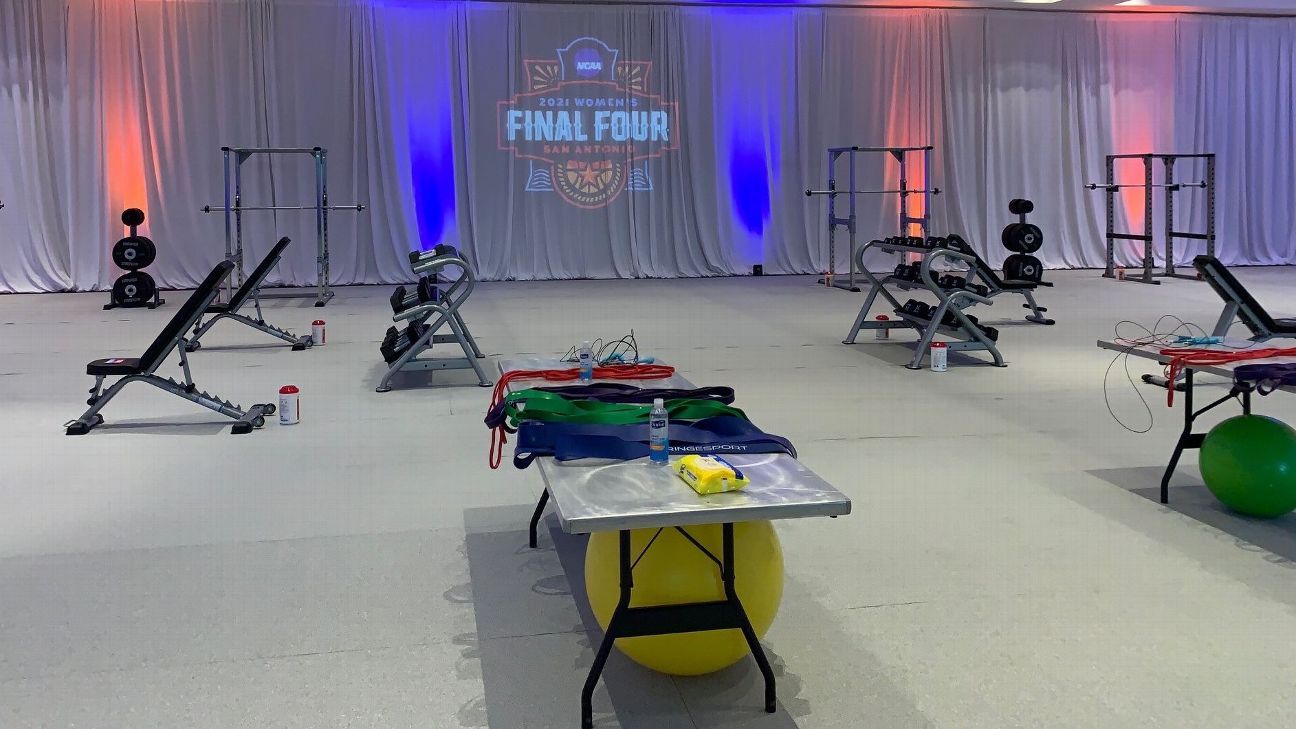The NCAA has improved its weight training facilities for the women’s basketball tournament in San Antonio, with more equipment being taken to the convention center where the teams train.
The teams were training inside the Henry B. Gonzalez Convention Center on Saturday morning. In addition to nine training courts, the weight training facilities that now have heavier weights, six squat racks, benches, resistance bands and exercise balls, all socially distanced, are expanded. There are also areas next to the practice courts with exercise bikes, rowing machines, treadmills, yoga mats and updated weight equipment.
“It was great. It’s good. Everything we needed,” said Louisville coach Jeff Walz. “Our strength coach was satisfied, our players were satisfied. We appreciate the efforts. ”
NCAA basketball vice president Dan Gavitt apologized on Friday for the disparity in facilities between the men’s and women’s tournaments, acknowledging that the NCAA fell short. These discrepancies have led some, including South Carolina coach Dawn Staley and UConn coach Geno Auriemma, to say that the situation reflects the general inequality to which women’s programs are accustomed.
The National Collegiate Players’ Association, a reform advocacy group that helped organize player protests this year, called on the NCAA on Saturday to address inequality in its sports more broadly and should adopt rules that require all member schools comply with and apply Title IX compliance.
The National Association of Basketball Coaches, the men’s basketball training organization, released a statement on Saturday in support of women.
“The NABC is wholeheartedly alongside our colleagues at the Women’s Basketball Coaches Association and student basketball athletes in the ongoing effort for equal opportunities,” said NABC Executive Director Craig Robinson in a statement. “College basketball coaches and student athletes – men and women – have endured a myriad of challenges and sacrifices to reach this point in an unprecedented season, and everyone deserves adequate amenities and championship experiences.”
NCAA officials told Holly Rowe of ESPN that one of the problems was that the COVID-19 women’s testing area at the convention center takes up too much space. Officials also said that the large open space outside the women’s practice courts, which was shown in photos on social media, was intended for a “waiting area” for the teams while waiting for the courts to be cleaned.
The area that now has the expanded weight room is not completely closed, but curtains have been placed around it.
Sedona Prince, from Oregon, who drew attention to the disparity on social media on Thursday, accessed Twitter on Saturday to thank the NCAA for helping to resolve the situation.
Social media is powerful. Thank you for all your support pic.twitter.com/YR5ZNwywv6
– Sedona Prince (@sedonaprince_) March 20, 2021
The original plan was to build a larger weight room for Sweet 16, converting one of the training courts for that purpose, since fewer courts will be needed at that point in the tournament. The NCAA did not explain why the same facilities would not be available for all 64 teams, instead of the 16 finalists.
Much of the exercise equipment being used now in San Antonio has already been ordered or waiting to be assembled by the NCAA for the original Sweet 16 plan. Officials told ESPN that the NCAA did not accept offers made through the social networks of several companies to provide equipment for women.
Authorities again said that free gift bags for men and women were of equal value, although some social media publications seem to suggest a disparity. Male and female players also have the same “virtual gift suite”, where they can select gifts.
As for problems with food availability in the first days that the teams were in San Antonio, NCAA officials told ESPN that it was based on the service of different hotels where the teams were staying. The organizing committee has been working with local restaurants to bring different food to those who are dissatisfied.
Prince’s mother, Tambra, said on Saturday that she hopes the NCAA will seize this opportunity to be more proactive in creating equal rights for women athletes.
“Instead of imposing rules that treat college athletes as NCAA property, the NCAA can choose to apply Title IX to ensure that athletes are treated equally in NCAA sports,” said Tambra Prince. “The reason this is not happening yet is because NCAA sports do not value equal rights for women as it values the monopoly of the name, image and likeness of college athletes.”
Dan Murphy of ESPN and The Associated Press contributed to this report.

